Evaluation of Turbulence Models in Unsteady Separation
Abstract
:1. Introduction
1.1. Motivation
1.2. Literature Review
1.3. Objectives
2. Methodology
2.1. Governing Equations
2.2. Problem Formulation
3. Results
3.1. Effect of Reduced Frequency
3.2. Effect of Pressure Distribution
4. Summary and Conclusions
- The turbulence model’s accuracy is comparable for the three models considered. They uniformly predict early separation, and the length of the recirculation region is generally overestimated.
- At the intermediate frequency, all turbulence models predict the downstream advection of the recirculation region that was observed in the resolved LES.
- The mean velocity profiles are reasonably accurate in the outer layer, the errors being concentrated in the near-wall region, especially near the separation and reattachment points.
- The Reynolds shear stresses are over-predicted during the acceleration phases, as observed previously [32].
- The drag is predicted with good accuracy, the integrated error (IE) remains always below 10% for all models.
- The results of Park et al. [32] resemble qualitatively our results, but the error there is larger. We conjecture that the error, in this case, is due to a combination of factors. In particular, the more dissipative character of the numerical method used for the RANS calculations, coupled with the coarser grid used, could result in additional diffusion. In our case, numerical errors were the same for the RANS calculations and the LES.
Supplementary Materials
Author Contributions
Funding
Data Availability Statement
Conflicts of Interest
References
- Simpson, R.L. Review—A Review of Some Phenomena in Turbulent Flow Separation. J. Fluids Eng. 1981, 103, 520–533. [Google Scholar] [CrossRef]
- Perry, A.E.; Fairlie, B.D. A study of turbulent boundary-layer separation and reattachment. J. Fluid Mech. 1975, 69, 657–672. [Google Scholar] [CrossRef]
- Patrick, W.P. Flowfield Measurements in a Separated and Reattached Flat Plate Turbulent Boundary Layer. Final Report; NASA contractor report NASA-CR-4052; National Aeronautics and Space Administration: Washington DC, USA, 1987. [Google Scholar]
- Simpson, R.L. Turbulent Boundary-Layer Separation. Annu. Rev. Fluid Mech. 1989, 21, 205–232. [Google Scholar] [CrossRef]
- Na, Y.; Moin, P. Direct numerical simulation of a separated turbulent boundary layer. J. Fluid Mech. 1998, 370, 175–201. [Google Scholar]
- Abe, H. Reynolds-number dependence of wall-pressure fluctuations in a pressure-induced turbulent separation bubble. J. Fluid Mech. 2017, 833, 563–598. [Google Scholar] [CrossRef]
- Wu, W.; Piomelli, U. Effects of surface roughness on a separating turbulent boundary layer. J. Fluid Mech. 2018, 841, 552–580. [Google Scholar] [CrossRef]
- Ambrogi, F.; Piomelli, U.; Rival, D.E. Characterization of unsteady separation in a turbulent boundary layer. J. Fluid Mech. 2022, 945, 1–30. [Google Scholar] [CrossRef]
- Durbin, P.A. Separated flow calculations with the k-ε-v2 model. AIAA J. 1995, 33, 659–664. [Google Scholar]
- Jin, G.; Braza, M. Two-equation turbulence model for unsteady separated flows around airfoils. AIAA J. 1994, 32, 2316–2320. [Google Scholar] [CrossRef]
- Basu, D.; Hamed, A.; Das, K. DES, hybrid RANS/LES and PANS models for unsteady separated turbulent flow simulations. In Proceedings of the Fluids Engineering Division Summer Meeting, Houston, TX, USA, 19–23 June 2005; Paper FEDSM2005-77421. Volume 41995, pp. 683–688. [Google Scholar]
- Hamed, A.; Basu, D.; Das, K. Assessment of multiscale resolution for hybrid turbulence model in unsteady separated transonic flows. Comput. Fluids 2007, 36, 924–934. [Google Scholar] [CrossRef]
- Covert, E.E.; Fletcher, M.J.; Flittie, K.J.; Linton, S.W. On the Unsteady Characteristics of Flows around an NACA 0012 Airfoil; Technical Report; MIT Center for Aerodynamic Studies: Cambridge, MA, USA, 1986. [Google Scholar]
- Schatzman, D.M.; Thomas, F.O. An experimental investigation of an unsteady adverse pressure gradient turbulent boundary layer: Embedded shear layer scaling. J. Fluid Mech. 2017, 815, 592–642. [Google Scholar] [CrossRef]
- Leishman, G.J. Principles of Helicopter Aerodynamics with CD Extra; Cambridge University Press: Cambridge, UK, 2006. [Google Scholar]
- Covert, E.E.; Lorber, P.F. Unsteady turbulent boundary layers in adverse pressure gradients. AIAA J. 1984, 22, 22–28. [Google Scholar] [CrossRef]
- Karlsson, S.K.F. An unsteady turbulent boundary layer. J. Fluid Mech. 1959, 5, 622–636. [Google Scholar] [CrossRef]
- Kenison, R.C. An experimental study of the effect of oscillatory flow on the separation region in a turbulent boundary layer. In Proceedings of the Unsteady Aerodynamics, AGARD Conference Proceedings, Ottawa, ON, Canada, 26–28 September 1977; Volume 227. [Google Scholar]
- Parikh, P.G.; Reynolds, W.C.; Jayaraman, R. Behavior of an unsteady turbulent boundary layer. AIAA J. 1982, 20, 769–775. [Google Scholar] [CrossRef]
- Mullin, T.; Greated, C.A.; Grant, I. Pulsating flow over a step. Phys. Fluids 1980, 23, 669–674. [Google Scholar] [CrossRef]
- Wissink, J.G.; Rodi, W. DNS of a laminar separation bubble in the presence of oscillating external flow. Flow Turb. Combust. 2003, 71, 311–331. [Google Scholar] [CrossRef]
- Ambrogi, F.; Piomelli, U.; Rival, D.E. Characterization of unsteady separation in a turbulent boundary layer: Reynolds stresses and flow dynamics. J. Fluid Mech. 2023, 972, A36. [Google Scholar] [CrossRef]
- Wilcox, D.C. Turbulence modeling: An overview. In Proceedings of the 39th Aerospace Sciences Meeting and Exhibit, Reno, NV, USA, 8–11 January 2001. AIAA Paper 2001-0724. [Google Scholar]
- Baldwin, B.S.; Barth, T.J. A One-Equation Turbulence Transport Model for High Reynolds Number Wall-Bounded Flows. NASA Technical Memorandum TM 102847. Available online: https://arc.aiaa.org/doi/abs/10.2514/6.1991-610 (accessed on 27 September 2023).
- Spalart, P.R.; Allmaras, S.R. A One-Equation Turbulence Model for Aerodynamic Flows. Rech. AÉrospatiale 1994, 1, 5–21. [Google Scholar]
- Patel, V.C.; Yoon, J.Y. Application of Turbulence Models to Separated Flow Over Rough Surfaces. J. Fluids Eng. 1995, 117, 234–241. [Google Scholar] [CrossRef]
- Menter, F.R. Two Equation Eddy Viscosity Turbulence Models for Engineering Applications. AIAA J. 1994, 32, 1598–1605. [Google Scholar] [CrossRef]
- Ekaterinaris, J.A.; Menter, F.R. Computation of oscillating airfoil flows with one- and two-equation turbulence models. AIAA J. 1994, 32, 2359–2365. [Google Scholar] [CrossRef]
- Nürnberger, D.; Greza, H. Numerical investigation of unsteady transitional flows in turbomachinery components based on a RANS approach. Flow Turb. Combust. 2002, 69, 331–353. [Google Scholar] [CrossRef]
- Schobeiri, M.T.; Abdelfattah, S. On the Reliability of RANS and URANS Numerical Results for High-Pressure Turbine Simulations: A Benchmark Experimental and Numerical Study on Performance and Interstage Flow Behavior of High-Pressure Turbines at Design and Off-Design Conditions Using Two Different Turbine Designs. J. Turbomach. 2013, 135, 061012. [Google Scholar] [CrossRef]
- Garnier, E.; Pamart, P.Y.; Dandois, J.; Sagaut, P. Evaluation of the unsteady RANS capabilities for separated flows control. Comput. Fluids 2012, 61, 39–45. [Google Scholar] [CrossRef]
- Park, J.; Ha, S.; You, D. On the unsteady Reynolds-averaged Navier–Stokes capability of simulating turbulent boundary layers under unsteady adverse pressure gradients. Phys. Fluids 2021, 33, 065125. [Google Scholar] [CrossRef]
- Na, Y.; Moin, P. The structure of wall-pressure fluctuations in turbulent boundary layers with adverse pressure gradient and separation. J. Fluid Mech. 1998, 377, 347–373. [Google Scholar] [CrossRef]
- Chen, H.; Patel, V. Near-wall turbulence models for complex flows including separation. AIAA J. 1988, 26, 641–648. [Google Scholar] [CrossRef]
- Chorin, A.J. Numerical solution of Navier-Stokes equations. Math. Comput. 1968, 22, 745–762. [Google Scholar] [CrossRef]
- Kim, J.; Moin, P. Application of a fractional step method to incompressible Navier-Stokes equations. J. Comput. Phys. 1985, 59, 308–323. [Google Scholar] [CrossRef]
- Keating, A.; Piomelli, U.; Bremhorst, K.; Nešić, S. Large-eddy simulation of heat transfer downstream of a backward-facing step. J. Turbul. 2004, 5, 20. [Google Scholar] [CrossRef]
- Yuan, J.; Piomelli, U. Numerical simulation of a spatially developing accelerating boundary layer over roughness. J. Fluid Mech. 2015, 780, 192–214. [Google Scholar] [CrossRef]
- Orlanski, I. A simple boundary condition for unbounded hyperbolic flows. J. Comput. Phys. 1976, 21, 251–269. [Google Scholar] [CrossRef]
- Piomelli, U.; Yuan, J. Numerical simulations of spatially developing, accelerating boundary layers. Phys. Fluids 2013, 25, 101304. [Google Scholar] [CrossRef]
- Weller, H.G.; Tabor, G.; Jasak, H.; Fureby, C. A tensorial approach to computational continuum mechanics using object-oriented techniques. Comput. Phys. 1998, 12, 620–631. [Google Scholar] [CrossRef]
- Morinishi, Y.; Lund, T.S.; Vasilyev, O.V.; Moin, P. Fully conservative higher order finite difference schemes for incompressible flows. J. Comput. Phys. 1998, 143, 90–124. [Google Scholar] [CrossRef]
- Bradshaw, P.; Young, A.D. Effects of Streamline Curvature on Turbulent Flow; Technical Report AGARD-AG-169; AGARD: Paris, France, 1973. [Google Scholar]
- Spalart, P.R.; Shur, M.L. On the sensitization of turbulence models to rotation and curvature. Aerosp. Sci. Technol. 1997, 5, 297–302. [Google Scholar] [CrossRef]
- Durbin, P.A.; Pettersson Reif, B.A. Statistical Theory and Modeling for Turbulent Flows, 1st ed.; Wiley: Hoboken, NJ, USA, 2001. [Google Scholar]
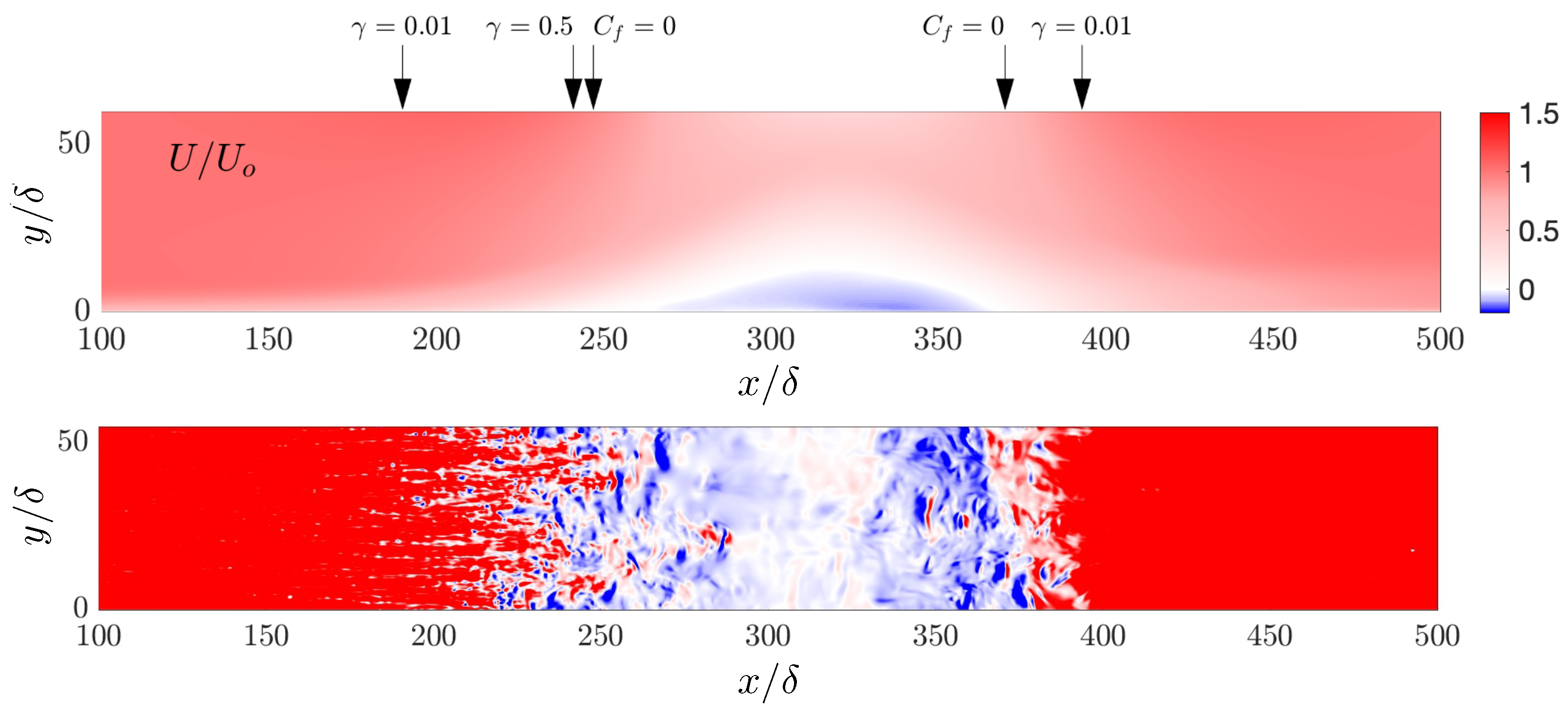

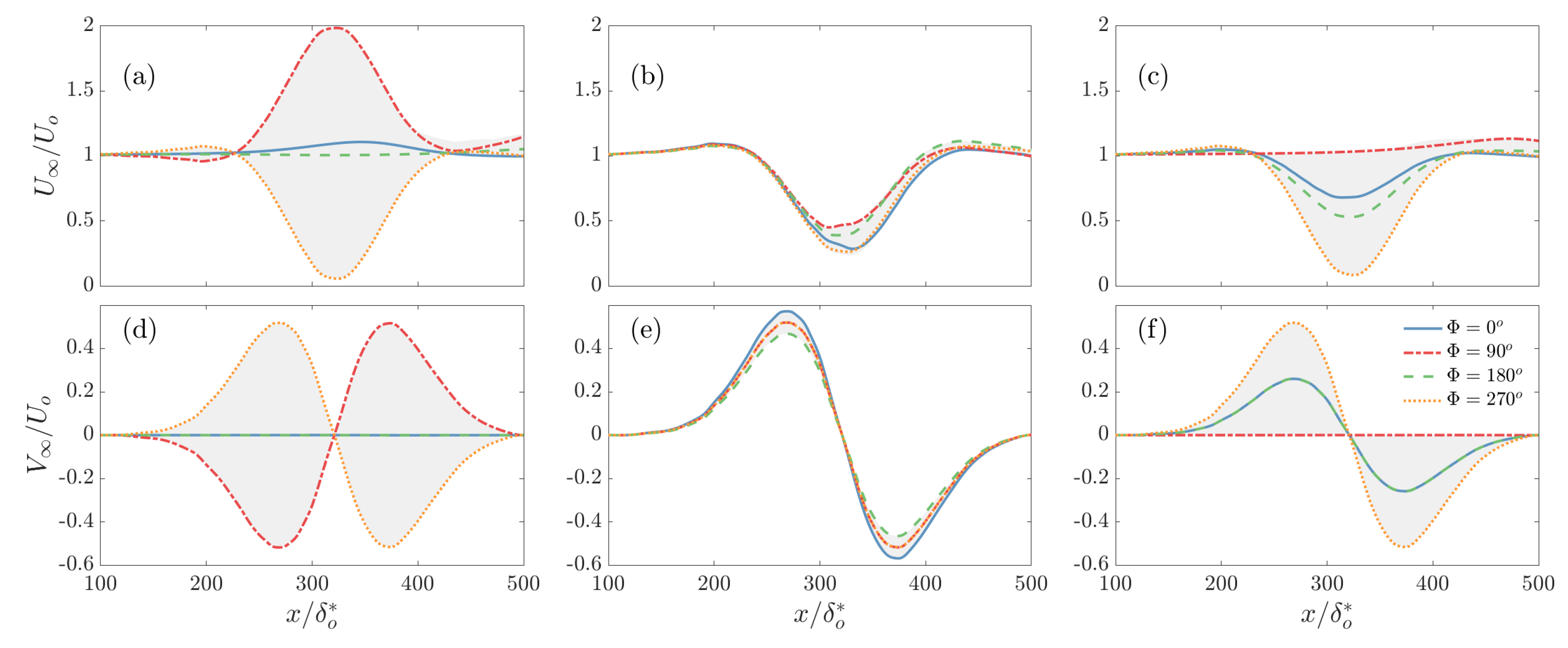
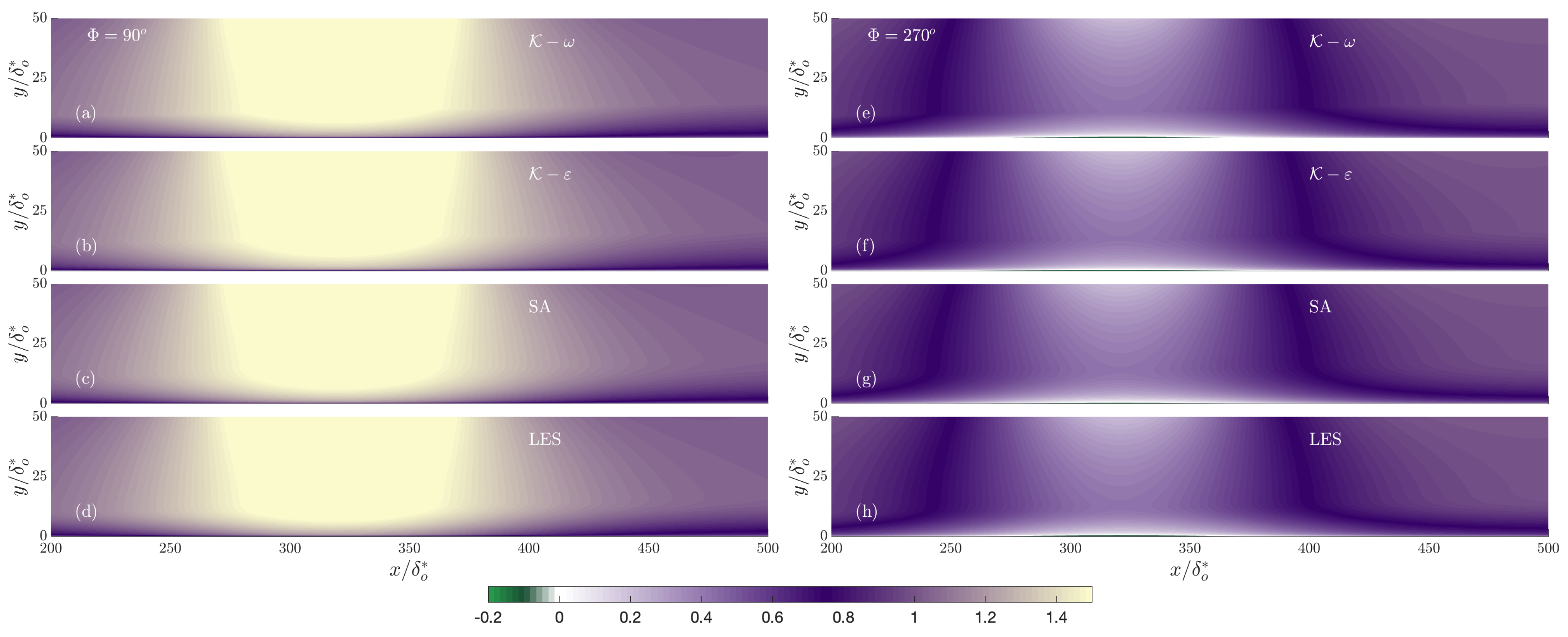
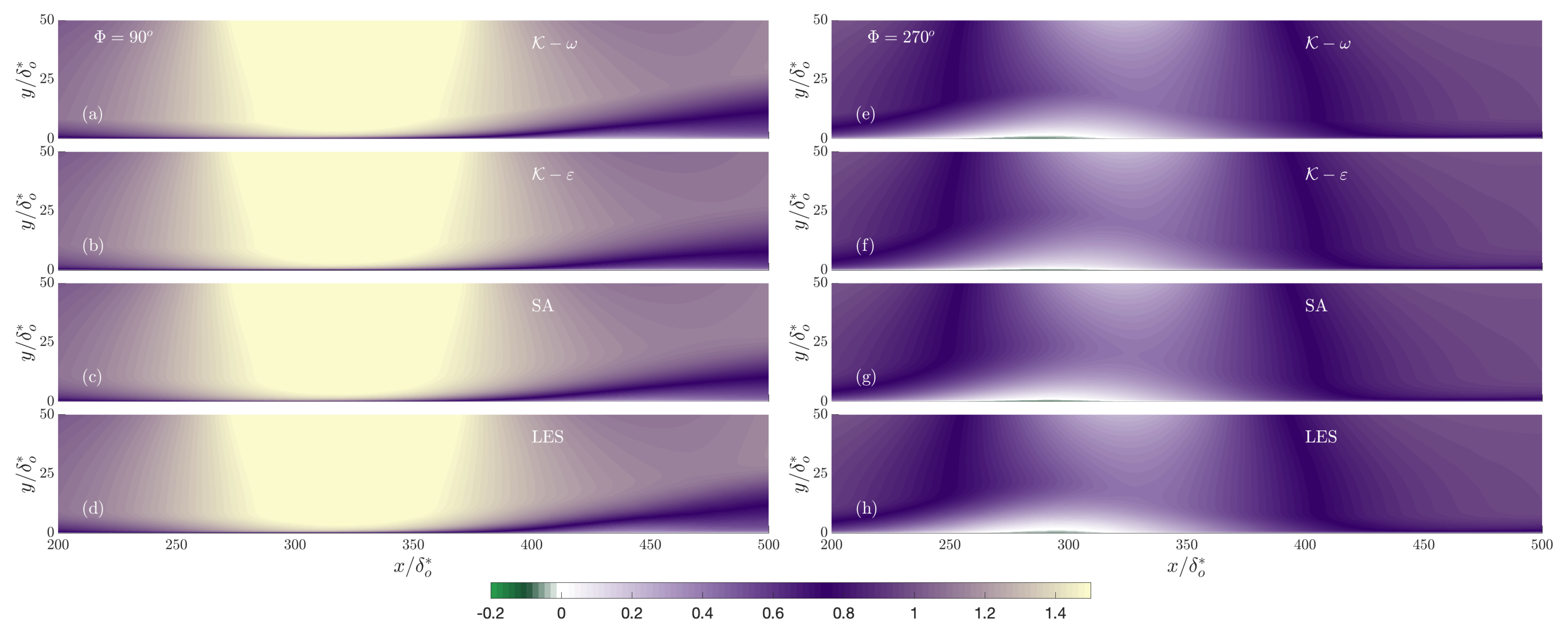
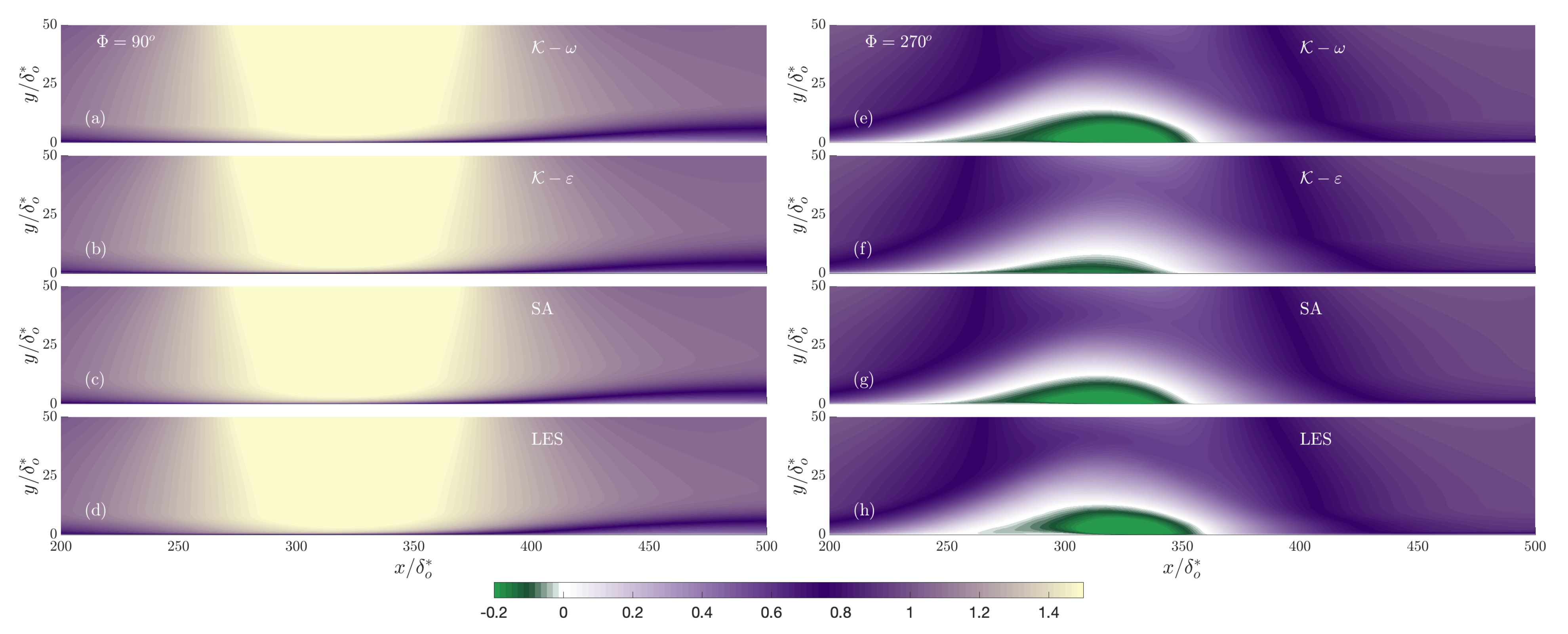
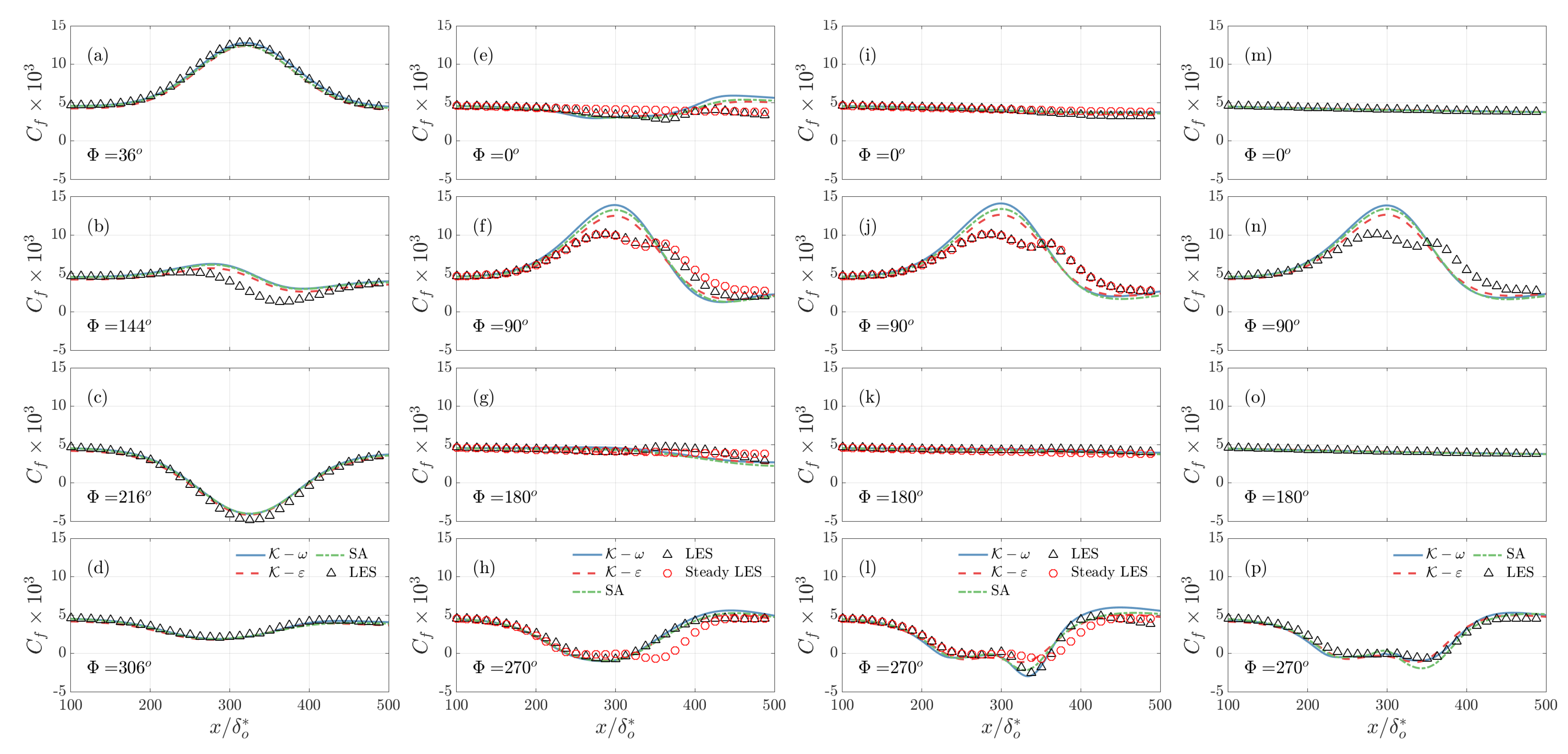


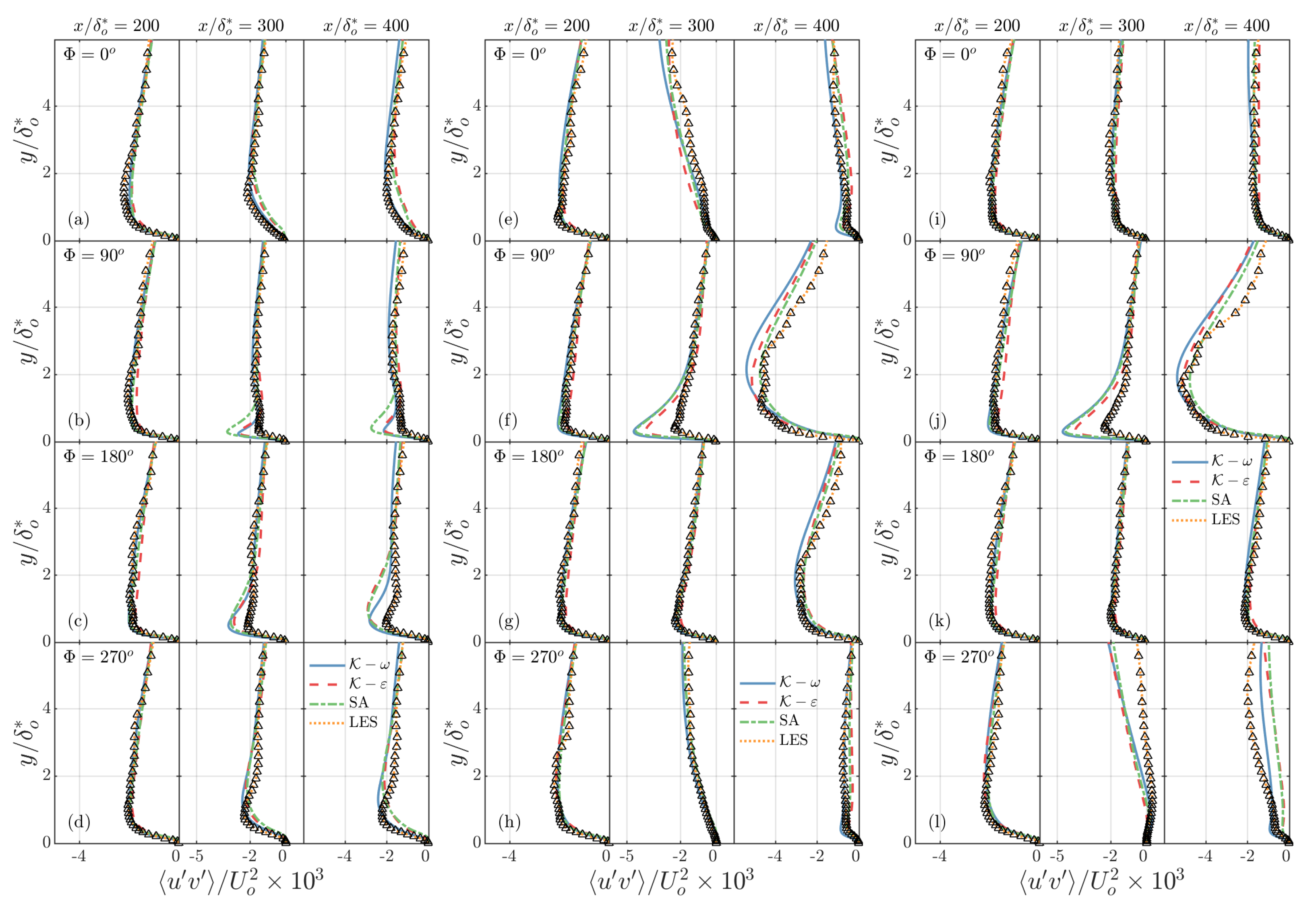
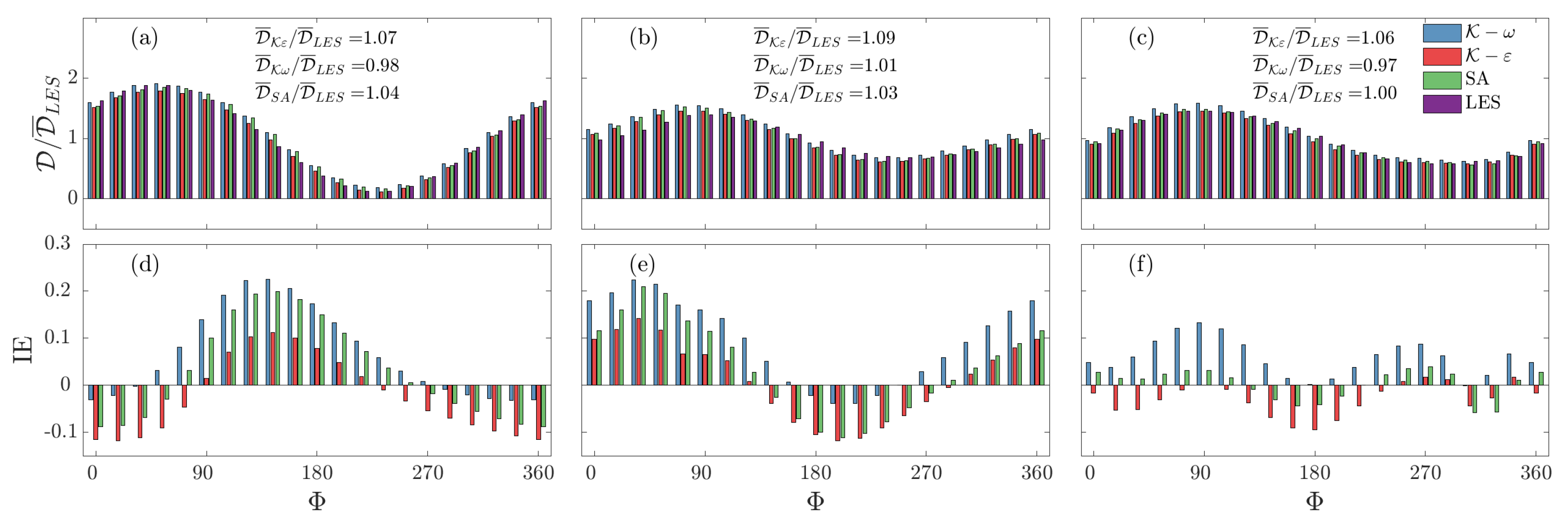
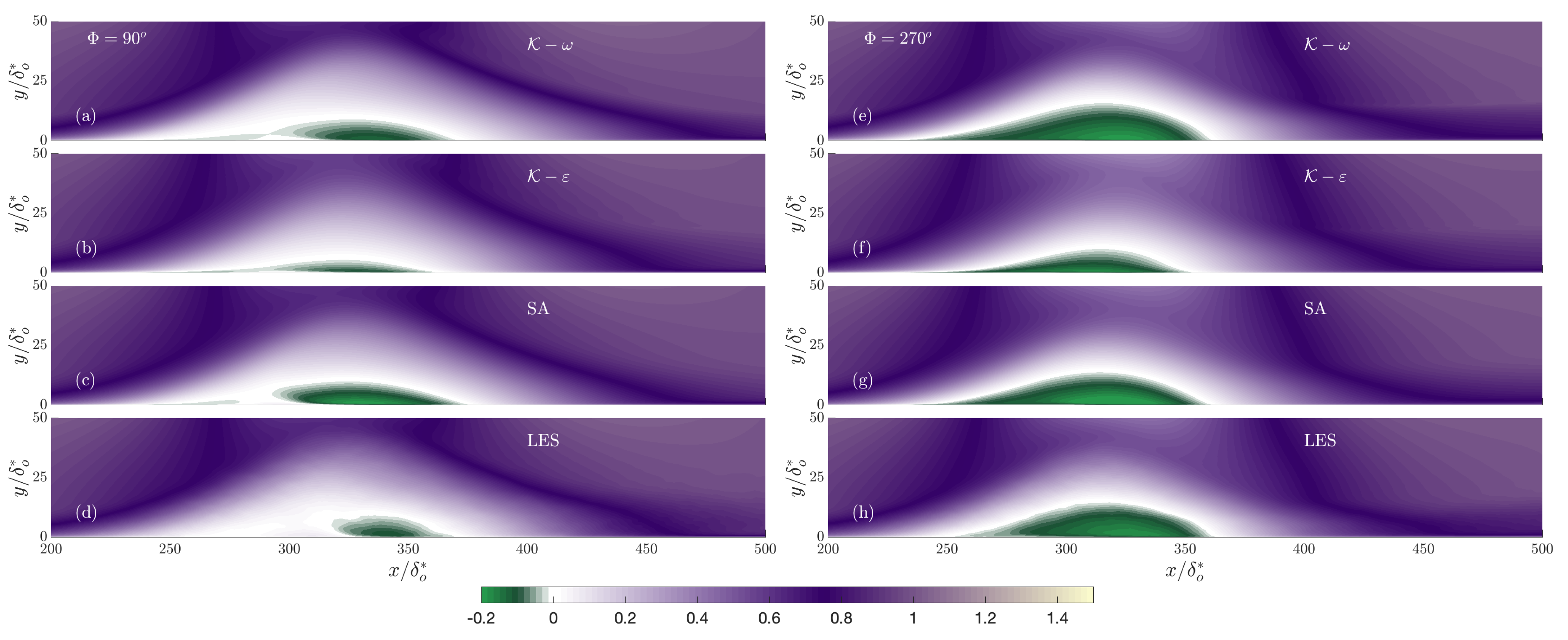
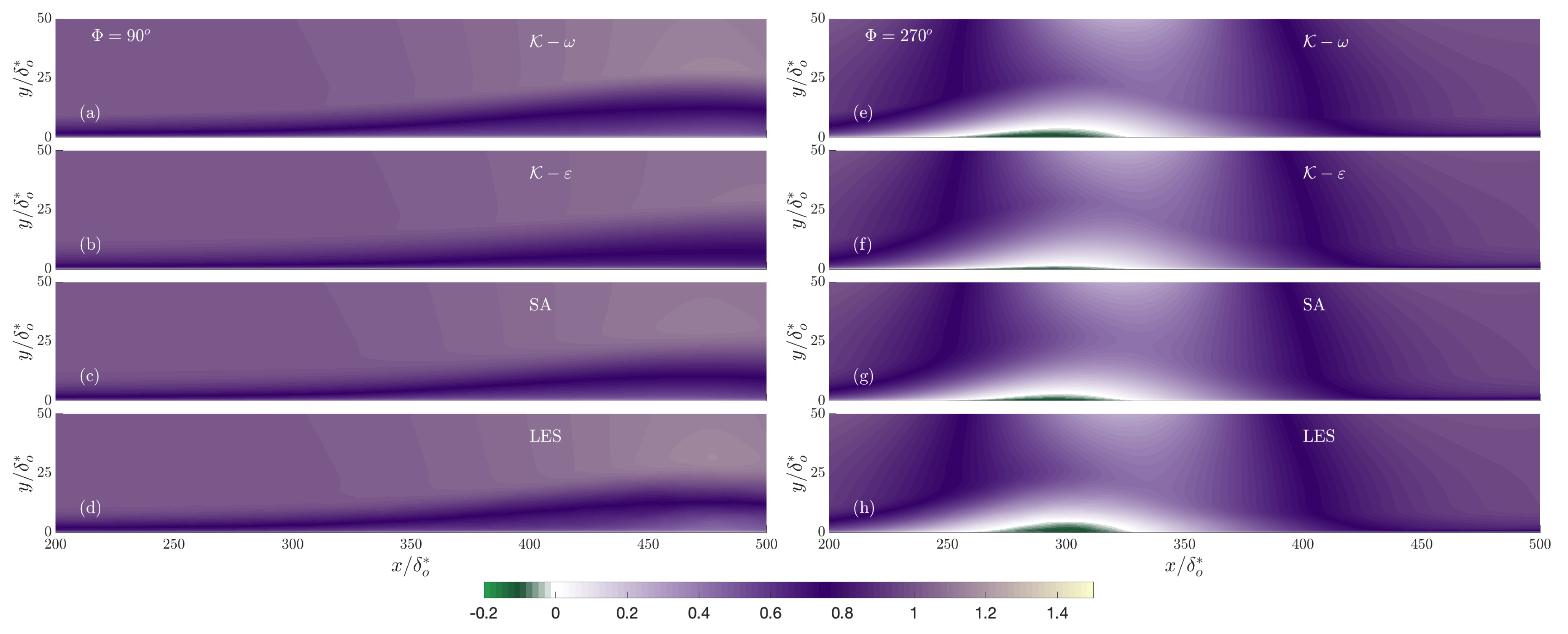


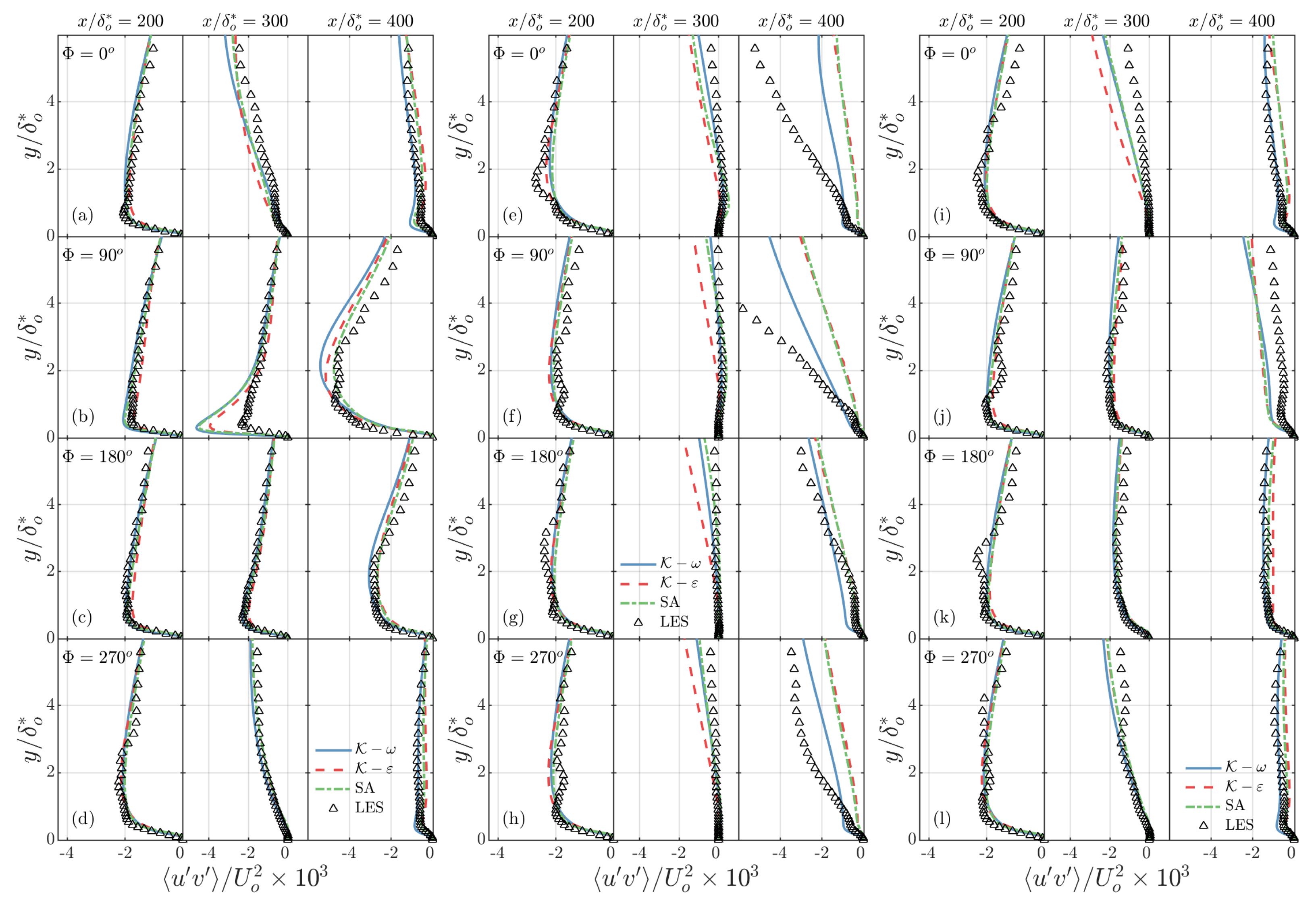
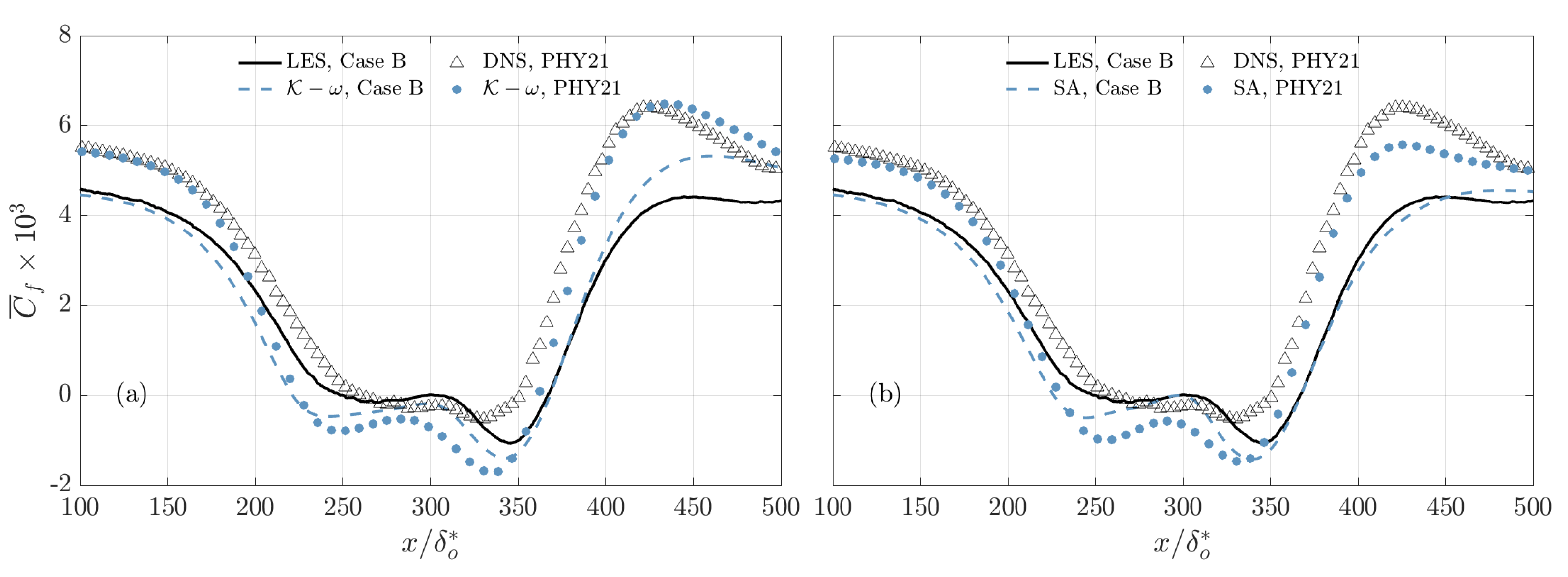
Disclaimer/Publisher’s Note: The statements, opinions and data contained in all publications are solely those of the individual author(s) and contributor(s) and not of MDPI and/or the editor(s). MDPI and/or the editor(s) disclaim responsibility for any injury to people or property resulting from any ideas, methods, instructions or products referred to in the content. |
© 2023 by the authors. Licensee MDPI, Basel, Switzerland. This article is an open access article distributed under the terms and conditions of the Creative Commons Attribution (CC BY) license (https://creativecommons.org/licenses/by/4.0/).
Share and Cite
MacDougall, C.Y.; Piomelli, U.; Ambrogi, F. Evaluation of Turbulence Models in Unsteady Separation. Fluids 2023, 8, 273. https://doi.org/10.3390/fluids8100273
MacDougall CY, Piomelli U, Ambrogi F. Evaluation of Turbulence Models in Unsteady Separation. Fluids. 2023; 8(10):273. https://doi.org/10.3390/fluids8100273
Chicago/Turabian StyleMacDougall, Claire Yeo, Ugo Piomelli, and Francesco Ambrogi. 2023. "Evaluation of Turbulence Models in Unsteady Separation" Fluids 8, no. 10: 273. https://doi.org/10.3390/fluids8100273





